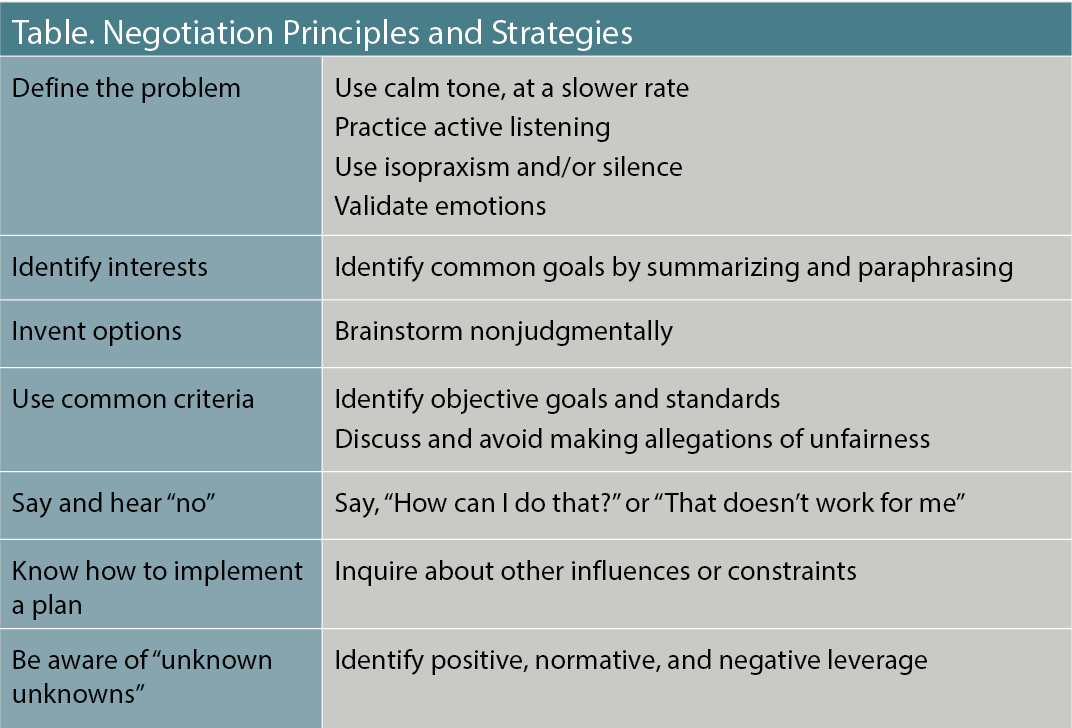Article
How Can Psychiatrists Become Better Negotiators?
Author(s):
Use these strategies to facilitate beneficial outcomes for patients, improve relationships with colleagues, and enhance workplace satisfaction.
Mr. Music_AdobeStock

Negotiation is a back-and-forth communication designed to reach an agreement.1 It serves 2 functions: information gathering and behavior influencing.2 Beyond our calling toward health care, doctors often find ourselves in the role of negotiator. Opportunities for negotiation include discussing treatment plans with patients and/or families, consulting specialist physicians about mutual patients, and making requests of administrators.
Clinical Vignette
“Mr L” is a 53-year-old man with history of schizophrenia, alcohol use disorder, type 2 diabetes mellitus, hypertension, 2 myocardial infarctions, and a cerebrovascular accident. He presented to the hospital with mental status changes and was admitted to the internal medicine service for hyperglycemia, hyponatremia, and alcohol withdrawal. Later, “Dr M,” the hospitalist, consults you about transferring Mr L to inpatient psychiatry because of suicidal ideation after the patient said, “I can’t go on like this.”
Dr M: Being medically stable, we are hoping for this transfer.
You: Hold on. I have concerns about his vital signs and abnormal laboratory values.
Dr M: No worry—those are both stable and should improve.
You: I am uncomfortable accepting Mr V since our nurses are not able to handle his medical problems if he gets worse.
Dr M: Oh, come on. He needs psychiatry—just take him.
You: No, he is not sufficiently stable to be appropriate here, given his current issues.
Dr M: (angrily): I am going to call and complain to the chief of staff.
You: Fine!
This is positional bargaining. The parties state their opinions, promote their positions while degrading opposing ones, and/or seek compromises or concessions. Positional bargaining can be inefficient, produce unwanted outcomes, and endanger social relationships.
A recommended approach is to acknowledge emotions, foster trust, and demonstrate empathy to establish rapport. This leads to open discussion of rational options obtained through principled negotiation.1 These principles and techniques are listed in the Table.
Table. Negotiation Principles and Strategies

Define and Separate the Current Problem From the Interpersonal Issues
The unsolved matter is the problem, not the other person.1,2 Describe the problem using a calm, reasonable tone, at a slower rate, and practice active listening. This creates psychological safety and invites counterparts to share their needs. For guarded or dismissive individuals, repeating what the other party said (isopraxism) or allowing a few moments of silence may invite them to disclose more information.2
Recognizing and validating the other person’s emotions provides momentum for collaborative problem-solving. Overtly stating your understanding of their position facilitates positive momentum. Do not deny or ignore emotions like anger or fear that present. Instead, use “tactical empathy,” which nonjudgmentally recognizes and labels your counterpart’s perspective without necessarily agreeing with it.2 Phrases such as “it sounds like” and “it seems like” are helpful. For hesitant or terse individuals, consider making an “accusation audit” by listing complaints they might have about you or your team; that might invite more mutual discussion.2
Identify Interests Rather Than Positions
Interests are desires and/or concerns that motivate people to develop and promote or defend a position. The most powerful of these are the needs for security, well-being, belonging, recognition, and control over one’s life.1 Numerous issues are included in a single position, so it is easier to identify and reconcile interests rather than positions. Appreciation of another person’s situation is a powerful negotiation skill.1
To identify the other party’s interests, consider “why” and “why not” they have taken their position. If you accurately mirror, label emotions, paraphrase, and summarize the other person’s stance and interests, they might agree with your impressions. If so, hearing “that’s right” breaks down barriers and indicates agreement.2 In contrast, simply being told “you’re right” may be a superficial comment in an effort to terminate discussion.
Invent Multiple Options for Mutual Gains
Judging prematurely, assuming or seeking a “single-answer” solution, seeking an “either-or” resolution, and failing to consider the problems of the other party are roadblocks to agreeing on mutually beneficial options.1 Try nonjudgmentally brainstorming for possible outcomes. The similarity principle—whereby we trust and/or like individuals who have attitudes, beliefs, or ideas similar to our own—may help in building trust.2
Use Common Criteria
While devising possible solutions, it is easier to negotiate when both sides are discussing common criteria rather than when one party attempts to force the other to “back down.” Citing objective goals increases the likelihood that the solution will be “wise and fair.” Examples of such standards include scientific judgements, cost, reciprocity, precedent, and efficiency.
Avoid any allegations of unfairness, which can trigger defensiveness and irrational decisions.2 Invite the other team at the onset of your discussion to immediately alert you if they feel they are treated unfairly. If they suggest unfairness, stop the discussion and ask them to please tell you how they felt they were unfairly treated.2 If the other team proposes a solution and then quickly labels it as “fair” to pressure you to agree, invite them to provide supporting evidence of fairness to both sides before agreeing to it.2
Be Comfortable Saying—and Hearing—“No”
The word “no” is the start, not the end of a negotiation.2 It provides a sense of control and may mean various things, such as “I’m not ready to agree,” “I don’t understand,” or “I need to think/talk it over.” This can lead to solution-based questioning. Conversely, premature agreeableness early in a negotiation may be superficial and not foster commitment. Making erroneous statements or mislabeling the other side’s position might elicit “no” from an otherwise hesitant or overly agreeable party. In cases where an initial proposal is unacceptable, you too can say “no” in subtle ways, such as “How am I supposed to do that?” “Sorry, that does not work for our team,” or “I just cannot do that.”
When negotiating with aggressive individuals, a deferential approach with open-ended questions is recommended, as it calms a high-pressure approach, slows the pace, and allows both parties to say “no.”2 Asking open-ended questions—using “how” or “what”—often diminishes defensiveness. This creates an atmosphere of asking for help, promotes goodwill, gives the other party a feeling of control, and replaces a potential confrontation with joint problem-solving.2
“Yes” is Nothing Without “How”
In many negotiation situations, there are other members involved on each side. It is important to remember the “hidden negotiation” that may occur independently with their other team members. They can either help implement or block a negotiated plan. Asking, “How does this affect the rest of the team?” or “What do your colleagues see as challenges?” helps ensure agreement and successful plan implementation.2 Pay attention to verbal tone and body language; incongruence with the individual’s verbal message signals uncertainty or hesitation.
Be Aware of “Unknown Unknowns”
In any negotiation, there may be incomplete information, behind-the-scenes constraints, or other interests of which one or both negotiators may be unaware. Using leverage may reveal these “blocks” through person-to-person contact and/or informal moments.2 There are 3 types of leverage2:
- Positive leverage: the ability to provide or withhold what the other side wants
- Negative leverage: things that could negatively impact the other side
- Normative leverage: using the other party’s own standards to illustrate any positional inconsistencies
Concluding Thoughts
After implementing these strategies, here is an alternative to the scenario in the Clinical Vignette.
Dr M: We’d like to get him to the psychiatry floor; he is medically stable.
You: Sorry, but I am concerned about his vital signs and abnormal laboratory results.
Dr M: Those are stable and should improve.
You: Let us talk more about this problem. The patient has known mental health problems and presented with acute medical conditions, abnormal electrolytes, and alcohol withdrawal. Is that correct? (Identifying the problem and inviting collaboration)
Dr M: Yes, he is not acting right.
You: Not acting right? (Isopraxism)
Dr M: Yes, he is agitated and requesting sleep medication in addition to drugs every 4 hours for anxiety.
You: It sounds like your service has been busy and stressed, and is uncomfortable with treating this patient’s mental health issues. (Tactical empathy)
Dr M: That’s right.
You: I want to ensure that the patient is really medically stable, and I also must ensure unit and staff safety. Yes, we want what is best for our patient and the personnel.
Dr M: I agree. (Presenting shared interests with agreement)
You: Let’s brainstorm some options.
You and Dr M proceed to consider options such as continued psychiatric consultation while the patient remains on the medical floor; transferring to inpatient psychiatry unit with medical backup; and stabilizing medical problems, followed by an outpatient psychiatric referral. Dr M notes off-handedly that he is going on vacation soon and wants the patients on his service to be “squared away” for the covering hospitalist (a possible “unknown unknown”).
You and Dr M finally agree to continue consultation while the patient is on the medicine service for now, and once laboratory and vital signs stabilize at mutually agreed-upon parameters and duration, you agree to expeditiously transfer Mr L to your psychiatry unit with the medicine team’s assistance (objective criteria).
Better negotiation skills facilitate beneficial outcomes for patients, improve relationships with colleagues, and enhance workplace satisfaction.
Dr Scarff is a staff psychiatrist at Veterans Affairs Medical Center in Lexington, Kentucky. Dr Lippmann is professor emeritus at the University of Louisville School of Medicine in Louisville, Kentucky.
References
1. Fisher R, Ury W, Patton B. Getting to Yes: Negotiating an Agreement Without Giving In. 2nd Edition. Penguin Putnam; 2006.
2. Voss C. Never Split the Difference: Negotiating as if Your Life Depended On It. 1st Edition. Harper Collins; 2016.






